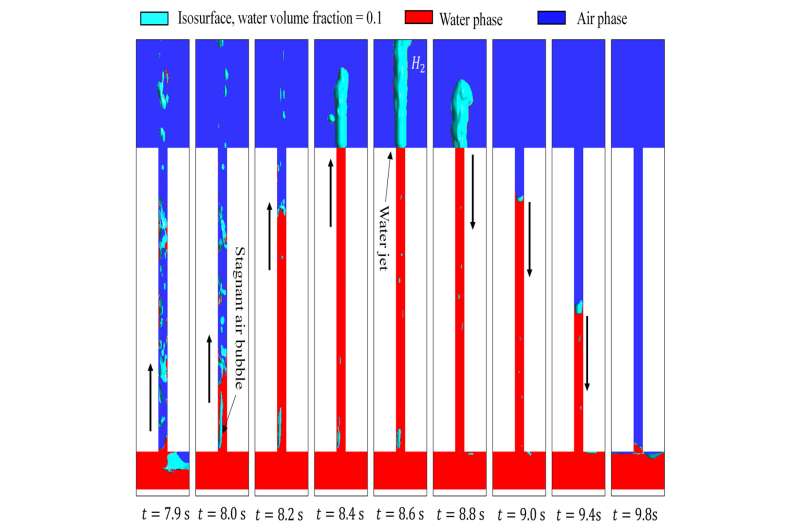This article has been reviewed according to Science X's editorial process and policies. Editors have highlighted the following attributes while ensuring the content's credibility:
fact-checked
peer-reviewed publication
trusted source
proofread
Stopping storms from creating dangerous urban geysers

During intense rainstorms, residents of urban areas rely on stormwater sewers to keep streets and homes from flooding. But in some cases, air pockets in sewers combine with fast-moving water to produce waterspouts that can reach dozens of feet high and last for several minutes. These so-called storm geysers can flood the surrounding area, cause damage to nearby structures, injure bystanders, and compromise drainage pipes.
Researchers from Sichuan University, Ningbo University, University of Alberta, and Hohai University developed a computational model of stormwater piping to study storm geysers. They used this model to understand why storm geysers form, what conditions tend to make them worse, and what city planners can do to prevent them from occurring.
The article "Modeling geysers triggered by an air pocket migrating with running water in a pipeline" is authored by Xin Li, Jianmin Zhang, David Z. Zhu, and Shangtuo Qian. It will appear in Physics of Fluids on April 11, 2023.
Perhaps the biggest cause of storm geysers is poor city planning. With extreme weather events becoming more common due to climate change, cities can often find themselves unprepared for massive amounts of rain. Growing cities are especially vulnerable. Small cities have small drainage pipes, but new streets and neighborhoods result in added runoff, and those small pipes may not be able to handle the increased volume.
"This can lead to pressurized flow and the potential for air pockets to become entrapped and transported through the pipeline," said author Jianmin Zhang, of Sichuan University. "These air pockets can ultimately be discharged through maintenance holes, resulting in storm geysers."
The authors say the best cure for a storm geyser is bigger pipes.
"The most effective preventive measure for newly planned drainage pipelines is to increase the pipeline diameter and improve system design, which reduces the likelihood of full-flow conditions and eliminates storm geysers," said Zhang.
However, that advice is little help to cities with existing pipeline infrastructure. In these systems, the focus must be on minimizing the potential damage by reducing the height of the geysers, the volume of expelled water, or the resulting damage to the pipeline.
"Scholars have proposed prevention measures such as increasing the maintenance hole diameter, using expansion segments in maintenance holes, installing orifice plates, and adding structures to allow air release while preventing the outflow of water," said Zhang. "However, these measures often cannot achieve all of the aforementioned objectives simultaneously."
While their model provides substantial guidance to city planners, the team hopes to expand their work to evaluate a range of prevention measures and identify the best overall solutions.
"We plan to systematically evaluate existing prevention measures that have received significant attention from scholars, analyze their advantages and disadvantages, and propose a comprehensive measure that achieves optimal results," said Zhang. "Our ultimate goal is to apply this comprehensive approach in practical engineering applications to eliminate storm geysers."
More information: Xin Li et al, Modelling Geysers Triggered by an Air Pocket Migrating with Running Water in a Pipeline, Physics of Fluids (2023). DOI: 10.1063/5.0138342
Journal information: Physics of Fluids
Provided by American Institute of Physics





















